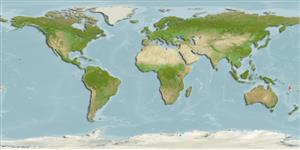Teleostei (teleosts) >
Ophidiiformes (Cusk eels) >
Dinematichthyidae (Viviparous brotula)
Etymology: Paradiancistrus: Named for its most similar genus, Diancistrus.; acutirostris: Named for its sharp, pointed snout..
More on authors: Schwarzhans, Møller & Nielsen.
Environment: milieu / climate zone / depth range / distribution range
Ecology
Marine; reef-associated; depth range 2 - 22 m (Ref. 57884). Tropical
Central Pacific: Vanuatu.
Size / Weight / Age
Maturity: Lm ? range ? - ? cm
Max length : 3.6 cm SL male/unsexed; (Ref. 57884); 4.7 cm SL (female)
Short description
Morphology | Morphometrics
Dorsal
soft rays
(total): 82-88;
Anal
soft rays: 66 - 71;
Vertebrae: 43 - 44. The species is characterized by the following: vertebrae 11+32-33=43-44, dorsal fin rays 82-88, anal fin rays 66-71; large eyes (2.6-3.1% SL); lower preopercular pores 1; outer pseudoclasper broad and wing-shaped, short and blunt; inner pseudoclasper a double winged broad flap, anteriorly joined to outer pseudoclasper forming a u-shaped feature, with supporter; very narrow scale patch on anterior part of cheek, only with 2 scale rows on upper cheek and single scale row on lower cheek; the head profile slender, with sharp, pointed snout (Ref. 57884).
Found in reef with sand at the base (Ref. 57884).
Life cycle and mating behavior
Maturity | Reproduction | Spawning | Eggs | Fecundity | Larvae
Schwarzhans, W., P.R. Møller and J.G. Nielsen, 2005. Review of the Dinematichthyini (Teleostei, Bythitidae) of the Indo-West-Pacific. Part I. Diancistrus and two new genera with 26 new species. The Beagle, Records of the Museum and Art Galleries of the Northern Territory 21:73-163. (Ref. 57884)
IUCN Red List Status (Ref. 130435)
Threat to humans
Harmless
Human uses
More information
Common namesSynonymsMetabolismPredatorsEcotoxicologyReproductionMaturitySpawningSpawning aggregationFecundityEggsEgg development
Age/SizeGrowthLength-weightLength-lengthLength-frequenciesMorphometricsMorphologyLarvaeLarval dynamicsRecruitmentAbundanceBRUVS
ReferencesAquacultureAquaculture profileStrainsGeneticsElectrophoresesHeritabilityDiseasesProcessingNutrientsMass conversion
Tools
Warning: mysqli::__construct(): (HY000/1040): Too many connections in /var/www/html/includes/speciessummary.lib.php on line 2414
Can't connect to MySQL database fbquizv2. Errorcode: Too many connections
